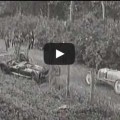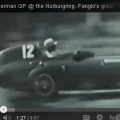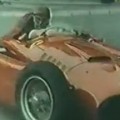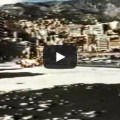The 1950 British Grand Prix was a Formula One motor race held on 13 May 1950 at the Silverstone Circuit in Silverstone, England. It was the first World Championship Formula One race in the modern era, as well as the fifth British Grand Prix, and the third to be held at Silverstone after motor racing resumed after World War II. It was the first round of the 1950 World Drivers’ Championship and the fifth race of the season.
The race, contested over 70 laps, was won by Giuseppe Farina for the Alfa Romeo team after starting from pole position timed 2:13:23.6, with an average speed of 146.378 km/h. Luigi Fagioli finished second in another Alfa Romeo, and Reg Parnell third in a third Alfa Romeo.
The race followed the non-championship Pau Grand Prix and San Remo Grand Prix (both won by Juan Manuel Fangio), the Richmond Trophy (won by Reg Parnell) and the Paris Grand Prix (won by Georges Grignard).
Held on 13 May at Silverstone Circuit, and also designated as the Grand Prix of Europe for 1950, this very first World Championship round was attended by George VI, Queen Elizabeth, Princess Margaret, and Earl & Countess Mountbatten of Burma.
In all, there were 22 competing, 21 qualified for race, and 11 classified. Numbers 7 and 13 were not assigned. The Alfa Romeo factory team arrived at the circuit with four 158s for Fangio, Farina, Fagioli & domestic driver Reg Parnell. Ferrari decided not to take part but there were a handful of Maseratis, one of them a factory car for Monegasque driver Louis Chiron. Scuderia Ambrosiana prepared two cars for David Hampshire and David Murray, Enrico Platé entered two drivers of aristocratic origin, Prince Bira of Siam and Baron Toulo de Graffenried. Joe Fry entered a private Maserati and Scuderia Milano entered Felice Bonetto, but he did not arrive. These cars were raced in Italian Rosso Corsa livery. Talbot-Lago sent over two factory cars in the traditional French pale blue colour to be driven by Yves Giraud-Cabantous and Eugène Martin. Other private Talbots were entered by Louis Rosier, Philippe Etancelin and Belgian Johnny Claes, in a yellow car. The rest of the field was made up of local machinery, which included four E.R.A.s and two Altas, in British racing green.
Farina was fastest in qualifying and the other three Alfas were alongside him on the front row. The second row consisted of “B. Bira” in a Maserati and the two factory Talbots. In accordance with the standard at the time, the rest of the grid consisted of rows of four and three alternating, up to the sixth row. Felice Bonetto was the only driver who did not take part in qualifying and would not take part in the race. On 13 May, 21 drivers from 9 countries were represented at the old Silverstone airport, 4 from France, 2 from Italy, 1 each from Belgium, Ireland, Monaco, Argentina, Thailand and Switzerland. The UK was represented by 9 drivers. The race drew 200,000 spectators. At the start of the race, Farina took the lead with Fagioli and Fangio in pursuit. In the early laps they switched around between themselves several times to keep everyone amused. Fangio retired with engine troubles and so Farina led Fagioli home by 2.5 seconds with Parnell a distant third despite hitting a hare during the race. The nearest challenger was Giraud-Cabantous two laps down, Bira having retired with a fuel problem. Crossley and Murray duelled at the back before retiring, de Graffenried had done so on lap 34, while Chiron was demoted to the role of viewer 10 laps earlier. Giuseppe Farina led for 63 laps (1–9, 16–37 and 39–70). Luigi Fagioli led for 6 laps (10–15). Juan Manuel Fangio led for 1 lap (38). Joe Fry drove car #10 for the first 45 laps, then Brian Shawe-Taylor took over for 19 laps for a total 64 laps, distance 297.536 km. Peter Walker drove car #9 for 2 laps, then Tony Rolt drove for and additional 3 laps, totaling 5 laps, a distance of 23.245 km.



